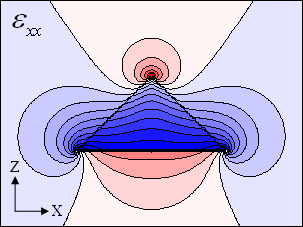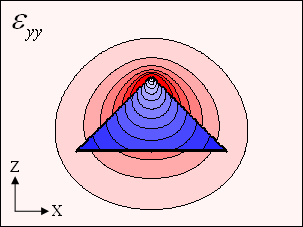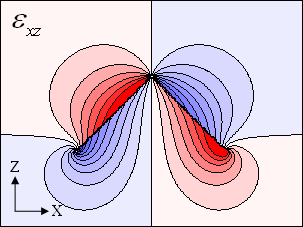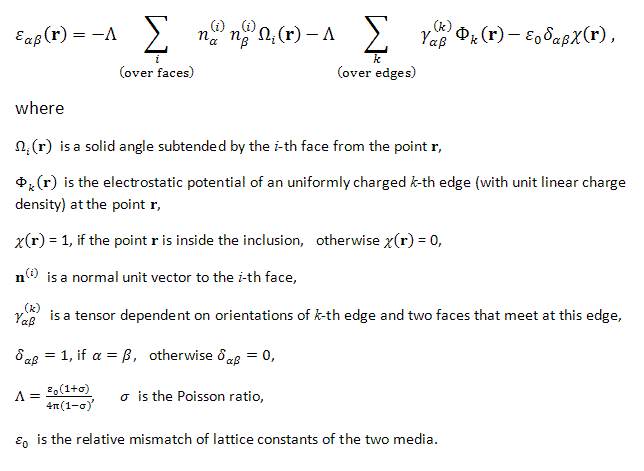
Hi All!
This site is devoted to the program EasyStrain.
What is EasyStrain for?
It calculates distribution of elastic strain in two- and three-dimensional structures, consisting of infinite matrix and an inclusion. The inclusion differs from the matrix by its crystal lattice constant.
Examples of such structures are semiconductor quantum dots and quantum wires.
For example, in this structure:

there is intrinsic mechanical stress, because lattice constant of indium arsenide is 6.7% greater than that of gallium arsenide. Spatial distribution of strain looks like this:





These pictures was calculated by the program EasyStrain.
For whom can EasyStrain be useful?
First of all, for specialists in semiconductor physics, whose area of interests includes quantum dots or quantum wires.
Perhaps this program can be of use for solving some problems of thermoelasticity, where inhomogeneity of temperature is the source of elastic strain (due to thermal expansion).
What is the difference from analogous programs?
EasyStrain carries out its calculation analytically, unlike other wonderful programs where the finite-element method (for example, in FlexPDE) or the finite-difference method (for example, in nextnano3) are used. This is the origin of all its advantages (and disadvantages :-( ).
Advantages:
EasyStrain does its job very quickly, and doesn't demand much memory.
The user shouldn't worry about such details as convergence, size of calculation volume, and grid spacing.
EasyStrain is a free, open-source software.
Disadvantages:
Matrix and inclusion are regarded as isotropic media.
Elastic moduli of the two media (matrix and inclusion) are considered to be equal.
Inclusion should be homogeneous in its chemical composition (no composition gradient).
Elimination of these disadvantages is in progress...
Download EasyStrain
"two-dimensional" program: executable for DOS/Windows, source code in C;
"three-dimensional" program: executable for DOS/Windows, source code in C.
This is the latest version of the program (number 0.9). Earlier releases are available here.
How to use this program?
It is explained here.
How does it work?
EasyStrain works on the basis of an analytical solution of the inclusion problem of theory of elasticity. This solution is described in the paper: A.V. Nenashev and A.V.Dvurechenskii, Strain distribution in quantum dot of arbitrary polyhedral shape: Analytical solution in closed form, arXiv:0707.2183. In this solution, an inclusion is presumed to have a shape of polyhedron. Strain tensor is found to express as a sum of contributions of faces and edges of the inclusion's surface:

The author
Alexey Nenashev, Institute of Semiconductor Physics, Novosibirsk, Russia.







